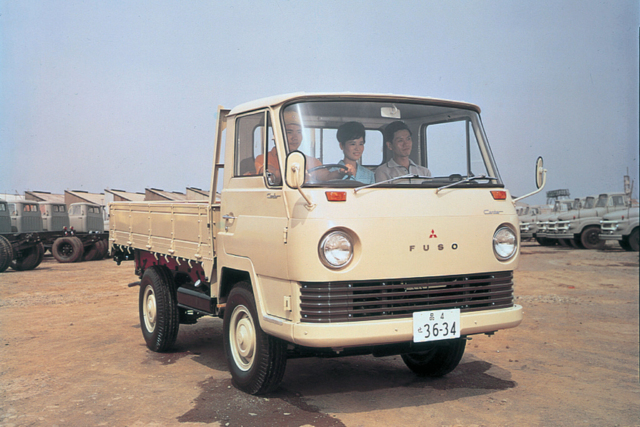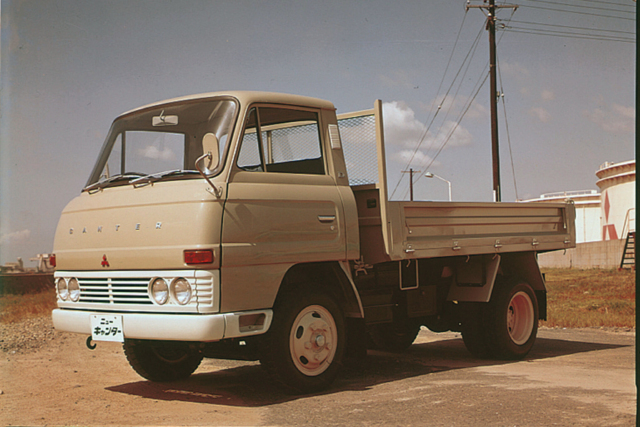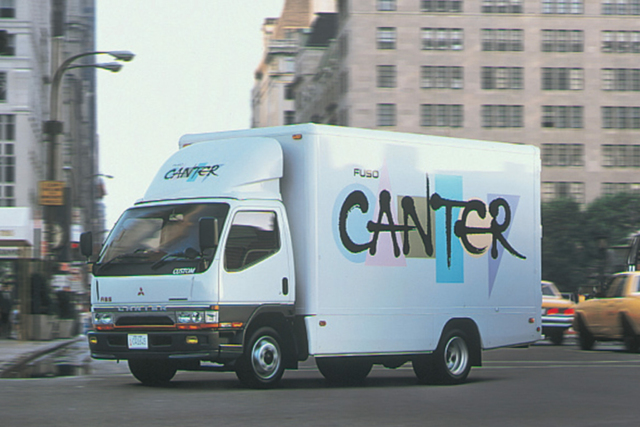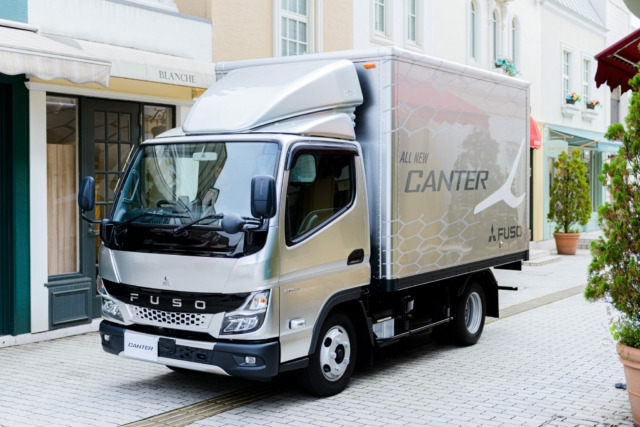Among the oldest nameplates in Japan’s auto industry is the Mitsubishi Fuso Canter. Though perhaps not as exciting as Nissan’s Skyline or Toyota’s Crown, the Canter has been a staple of Japanese roads for 60 years. The cabover light-duty truck has lasted for nine generations since its original mid-century robot face debuted in March 1963, on the eve of Japan’s first expressway opening.
The original Canter is an extremely rare beast nowadays. The dual-headlight configuration in the lead photo lasted just one year before a 1964 facelift added quad headlights. Either version of this first-generation truck, the T270 chassis, is very difficult to find. Even Mitsubishi itself does not have either example in its own hidden collection.
The payload capacity was two tons and engine options were either a gasoline engine making 90ps or a 2.0-liter diesel making 68ps. It debuted the same year Japan’s first expressway opened, making high-speed transportation of cargo possible for the firs time.
The second-generation T90 debuted in July 1968. Power came from one of three engines: gasoline units of 90 or 95 ps, or a 75ps diesel. Mitsubishi says they boasted the quickest acceleration in their class. A 1970 facelift gave the T90 a V-shaped grille with side markers at the corners of the grille and added an improved 2.7-liter diesel making 80ps.
While most of these early workhorses got used up, Mitsubishi does have a restored one T90 in their warehouse. You can still find them at the occasional car show or museum as well. By the time this generation came to an end in 1973, long-distance transport of cargo had become common. Trucks like the Canter helped fuel Japan’s economic boom years.
The third-generation T200 continued the V-grille, earning it the nickname “V Canter”. Incidentally, the name Canter comes from the movement of a horse, described by Merriam-Webster as “a 3-beat gait resembling but smoother and slower than the gallop”. Variations with 2.5- and 3-ton payload capacities were added.
A January 1975 update gave the Canter the same 2.0-liter 4G52 “Astron 80” engine as the Galant in order to meet new emission regulations. In July 1976 Mitsubishi unveiled a low-floor variant for easy loading that had smaller diameter wheels at the rear.
Debuting in 1978 was the fourth-generation FE1 and FE2, nicknamed “Golden Canter” because of the hero color in its ads. It spawned a dizzying array of variants, with payload capacities of 1.5, 2.0, 3.0, and 3.5 tons. Each corresponded to the Canter 15, Canter 20, Canter 30 and Canter 35 name. An additional wide cab with floor-mounted shifter gave the larger variants names like the Canter Wide 20, Canter Wide 30, and Canter Wide 35. Lest the Canter 15 feel left out, it got a “walkthrough” panel van variant with tall doors and flat floor (think UPS truck).
Mitsubishi also made use of its direct-injection know-how and offered a naturally aspirated 100ps diesel alongside a 120ps turbodiesel. Around this time, Mitsubishi Motors was moving from its traditional triple-diamond logo to either “MMC” lettering or a stylized “M” logo comprised of two triangles.
The fifth-generation FE3 and FE4 debuted in 1985 and returned to the triple-diamond logo. A 4WD option was added to Canter 20 and Canter 30 models, laying the groundwork for epic overlanding builds some 40 years later. In January 1987 the Canter 15 was renamed to Canter Guts, creating one of the all-time great JDM names. A new 130ps turbo engine was added to the options list as well.
The sixth-generation FE5 and FE6 arrived in 1993, and you’ve likely seen them on the streets in Japan if you’ve visited recently. A twin-caliper front brake system was developed by Akebono for this iteration and patented. A 4-ton version was added in October 1995 and and LPG fueled version in 1996. This generation lasted until 2002.
Over the years, the Canter has been mainly a cargo hauler, but examples have been converted to fire trucks, ambulances, tow trucks, flatbeds, dump trucks, and any other setup you can think of. It’s been sold in 70 countries around the world, with 12 local assembly plants across the globe. To us, generations one through six are the nostalgic ones, as they are over 25 years old and hail from the 20th century. But if you’re curious, the three remaining generations are below.
Additional Images:
Images courtesy of Mitsubishi.















